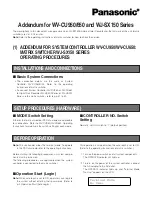
22. Serial Protocols
ROX™ v2.2 User Guide
219
RuggedBackbone™ RX1500
22.1.2. Serial Protocols Applications
22.1.2.1. Character Encapsulation
Character encapsulation is used any time a stream of characters must be reliably transported across
a network.
The character streams can be created by any serial device. The baud rates supported at either server
need not be the same. If configured, the router will obey XON/XOFF flow control from the end devices.
One of the servers is configured to listen to TCP connection requests on a specific TCP port number.
The other server is configured to connect to its peer on the listening port number. The RX1500 will
periodically attempt to connect if the first attempt fails and after a connection is broken.
The RX1500 can be used to connect to any device supporting TCP (e.g. a host computer’s TCP stack
or a serial application on a host using port redirection software).
22.1.2.2. RTU Polling
The following applies to a variety of RTU protocols besides ModBus RTU, including ModBus ASCII
and DNP.
The remote router communicates with host equipment through:
• native TCP connections,
• another RX1500 via a serial port or
• a port redirection package which Supports TCP.
If a RX1500 is used at the host end, it will wait for a request from the host, encapsulate it in a TCP
message, and send it to the remote side. There, the remote RX1500 will forward the original request
to the RTU. When the RTU replies, the the RX1500 will forward the encapsulated reply back to the
host end.
ModBus does not employ flow-control so XON/XOFF should not be configured.
The RX1500 maintains configurable timers to help decide replies and requests are complete and to
handle special messages such as broadcasts.
The RX1500 will also handle the process of line-turnaround when used with RS485.
22.1.2.3. Broadcast RTU Polling
Broadcast polling allows a single host connected RX1500 to “fan-out” a polling stream to a number of
remote RTUs.
The host equipment connects via a serial port to a RX1500. Up to 32 remote devices may connect to
the host server via the network.
Initially, the remote servers will place connections to the host server. The host server in turn is configured
to accept the required number of incoming connections.
The host will sequentially poll each RTU. Each poll received by the host server is forwarded (i.e.
broadcast) to all of the remote servers. All RTUs will receive the request and the appropriate RTU will
issue a reply. The reply is returned to the host server, where it is forwarded to the host.
















































